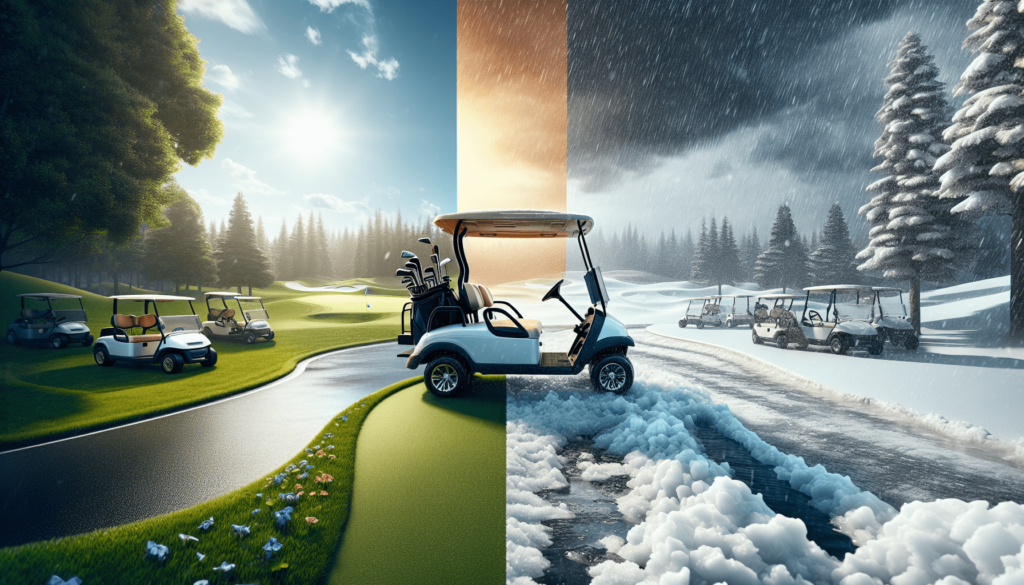Navigating through varying weather conditions while comfortably seated in a golf cart can seem like a delightful prospect, especially for those who casually use these transporters beyond the greens. However, the question that quite often arises is whether a golf cart can indeed withstand all types of weather conditions. Well, hold your golf clubs as we’re about to settle this query once and for all. Buckle up and let us traverse the uncertain terrain together, exploring the adaptability of golf carts in inclement weather conditions.

Overview of Golf Carts
Definition and purpose of golf carts
Golf carts, as we all know, are small vehicles designed initially to ferry golfers and their equipment within the bounds of golf courses, saving us from the effort of walking or carrying clubs. These compact vehicles, usually powered by electric or gas engines, have become integral to the game, facilitating the quick and efficient movement around vast courses.
Types of golf carts
In our experience, golf carts largely fall into two main categories: gas-powered and electric. Gas-powered golf carts, as the name indicates, operate on gasoline. They’re renowned for their power and longevity, making them suitable for dealing with rough landscapes and heavy loads. Meanwhile, electric golf carts run on rechargeable batteries. They are known for their quiet operation, cost efficiency, and are more environmentally friendly.
Common uses outside of golf courses
Golf carts aren’t not just restricted to the green. We’re seeing them adopted in various scenarios due to their versatility and compactness. They are increasingly prevalent in large residential communities, campuses, and big commercial establishments as a convenient means of transport for short distances. They are also widely used in events, airports, farms, and even in some urban areas as an alternative to conventional vehicles.
Weather Conditions and Vehicle Performance
How weather affects vehicles in general
Speaking generally, weather plays a crucial role in how any vehicle performs, and golf carts are no exception. Elements such as temperature, humidity, wind, rain, and snow can impact a vehicle’s condition, performance, and longevity. They can affect the battery life, tire grip, visibility, structural integrity, among many other aspects. Therefore, it’s crucial to understand weather impacts to better adapt and maintain them.
Specific challenges for small electric vehicles
Small electric vehicles, such as golf carts, come with their own unique set of challenges. The foremost being dependence on batteries. Weather extremes can influence battery performance and lifespan. In addition, these vehicles often lack the robust build of full-sized cars, making them less resistant to severe weather elements and more prone to wear and tear.
Temperature impacts on battery-operated carts
Temperature tends to have an unignorable impact on the performance of battery-operated golf carts. Dealing with batteries, we have found that very low temperatures can significantly reduce their capacity and efficiency. Conversely, if the temperature is too hot, it may lead to overheating or even damage the batteries.
Driving Golf Carts in Rainy Conditions
Safety precautions to consider
When driving golf carts in the rain, it is always essential to exercise caution. Ensure the brake pads are in optimal condition as wet surfaces reduce grip, increasing the likelihood of skidding. Headlights and tail lights should be kept on for visibility and windshields should be equipped with wipers or manually wiped regularly.
Modifications for waterproofing
Waterproofing golf carts, especially the electric ones, should be a top priority. You can protect the seats with waterproof covers and install enclosures to keep passengers and equipment dry. Most importantly, ensure the electric system is waterproofed to avoid short-circuits and damage to the battery.
Impact on terrain and cart performance
Wet terrain can significantly affect golf cart performance. Mud can reduce traction, resulting in a loss of control. Rainwater can also cause physical and electrical damages if the cart isn’t adequately safeguarded. It is advisable to reduce cart speed in such conditions to avoid accidents.
Navigating Golf Carts in Snow and Ice
Feasibility of using golf carts in snowy conditions
Operating golf carts in snowy conditions is indeed feasible but may require additional considerations. Traction, for one, can be challenging in snowy conditions. Equipping golf carts with snow tires or chains will certainly increase their grip on icy roads.
Required modifications for cold weather
Enhancing the power of heaters, as well as installing enclosures and using winter tires, are some of the modifications necessary for winter conditions. Installing a hard top to shield from falling snow, and adding weight to the rear of the cart to improve traction could be beneficial. Moreover, battery heaters or blankets can be used to ensure consistent battery performance during winter.
Safety advice for icy surfaces
On icy roads, smoothly steering, slowing down, and avoiding sudden braking or acceleration help prevent skids and maintain control. It is also recommended to maintain a safe distance from other vehicles as braking distances are increased in icy conditions.

Operating Golf Carts in High Temperature Conditions
Effects of heat on battery life and performance
High temperatures can negatively impact battery life and performance. Overheating can cause the battery to expand, resulting in damage and reducing its lifespan. Moreover, golf carts battery may drain quicker in hot conditions, affecting the cart’s range.
Cooling systems for golf carts
Despite golf carts not having a native cooling system like cars, external fans can be used for cooling passengers. For battery cooling, various devices are available, like thermal wraps and battery fans, that can help maintain optimal battery temperature.
Dealing with overheated engines or batteries
If the golf cart’s engine or battery becomes overheated, it is crucial to stop driving and let it cool down. If it’s persistent, consult a professional as they could suggest a better cooling solution or diagnose if there is a deeper issue.
Adapting Golf Carts for Various Weather Conditions
Available modifications
Modifications such as all-weather enclosures, tire chains, battery insulation wraps, hard tops, powerful heaters, cooling fans, waterproof covers, among other things, are available and can be quite handy in adapting golf carts to various weather conditions.
Cost considerations for weatherproofing
Weatherproofing a golf cart can entail additional costs, but these upfront costs can save in terms of maintenance, longevity, and safety in the long run. However, it’s important to consider which modifications are necessary based on the local climate and primary usage of the cart.
How to choose the right accessories
When deciding on accessories for a golf cart, consider the specific weather conditions it will encounter as well as the frequency and nature of its use. Factors like investment cost, installation ease, product reviews, and the hardness of weather conditions should guide your choice of accessories.
Maintenance Tips for All-Weather Golf Carts
Regular maintenance schedule
Regular service and check-ups help to ensure the long-term performance and safety of golf carts. Checking the tire pressure, motor, brakes, suspension, and the health of the battery should be part of your regular maintenance routine, no matter the season.
Preventive measures for different weather conditions
For high temperatures, ensure batteries are well-ventilated, and coolants are filled. In rainy conditions, inspect for water leaks in the electrical system. In winter, battery care should be prioritized, and antifreeze levels checked.
Long-term storage advice
When storing golf carts for an extended period, especially over winter, they should be kept clean, fully charged, covered, and in dry conditions to avoid corrosion and battery damage.
Legal and Safety Considerations
Road legality in varying weather
The legality of golf carts on roadways often varies by jurisdiction, and weather may play a factor in this. Some areas allow golf carts on roads only in fair weather while others may allow them in any weather, given they have necessary safety features installed.
Insurance implications
While operating golf carts, adequate insurance covering all possible scenarios is crucial. As weather conditions can alter the operation and safety of a golf cart, insurance should account for damages related to weather conditions.
Local laws and regulations concerning golf cart use
Local laws can vary, so understanding the legal requirements regarding golf cart operation in varying weather conditions is essential. This can include provisions for lighting, signaling, speed, and safety features, especially in public areas.
Advantages and Limitations of Golf Carts in Diverse Climates
Versatility of golf carts in mild versus extreme conditions
Golf carts are incredibly versatile in mild weather conditions, suitable for both recreational and commercial uses. However, they may pose challenges in extreme weather conditions and might require specific modifications for optimal performance and safety.
Comparison with other vehicles
Compared to other vehicles, golf carts are smaller, cheaper, and more environmentally friendly, making them beneficial for short-distance transportation. On the downside, they lack some of the features of full-sized vehicles, making them less efficient or comfortable in severe weather.
Considerations for golf course managers and homeowners
For golf course managers and homeowners, golf carts are highly valuable due to their cost-effectiveness, versatility, and convenience. However, it is necessary to consider weather conditions, maintenance requirements, and required modifications.
Future Developments in Golf Cart Technology
Emerging technologies for all-weather operation
Case studies show an increasing trend in golf cart innovation, with technologies emerging to brave all-weather conditions. This includes better battery technology, smarter materials for body construction, and more efficient heating and cooling options.
Research into more durable materials and designs
Research into stronger and more resistant materials are underway, which may extend the lifespan of golf carts, improve performance, and reduce maintenance. Furthermore, new designs that are more aerodynamic and weatherproof are being conceived.
Predictions for the future of golf cart usage
Given the ongoing advancements in technology, the future of golf carts seems promising. We expect them to be more adaptable to various weather conditions, be more robust and safe, and become an even more versatile mode of transportation. Developments in the electric power sector should only enhance this versatility and adaptability.




